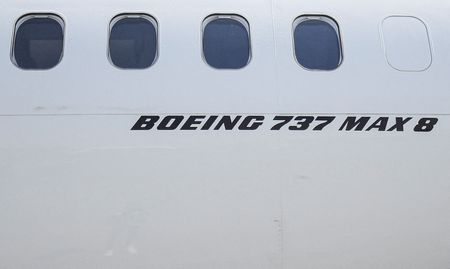By Valerie Insinna and Nathan Gomes
WASHINGTON (Reuters) -Boeing Co still plans to ramp up production of its best-selling 737 MAX passenger jet this summer, despite a recent manufacturing problem that has paused some deliveries, the planemaker’s CEO Dave Calhoun said on Tuesday.
Last week, Boeing indicated that near-term deliveries of the 737 MAX will slow as the company grapples with a new manufacturing problem involving fuselages built by Spirit AeroSystems.
The company is comfortable holding buffer stock as its supply chain ramps up production to support a planned increase from its current rate of 31 MAXs per month, Calhoun said during Boeing’s annual meeting. Boeing has sought to ramp up output of the MAX following two fatal plane crashes in 2018 and 2019 that killed 346 people and prompted it to curtail production until it fixed safety issues unrelated to the current manufacturing problem.
“We are not changing the supplier master schedule, including any anticipated rate increases,” Calhoun said.
Boeing shares rose 1% following Calhoun’s announcement.
Calhoun did not comment on whether the ongoing manufacturing issue will force Boeing to change its financial outlook or delivery guidance for 2023.
However, Calhoun said Boeing’s long term guidance for the 2025-2026 timeframe, which calls for the company to achieve about $10 billion in free cash flow and to produce about 50 737 MAXs per month, remains unchanged.
Boeing is expected to further detail the fallout of the problem during first quarter earnings on April 26.
Boeing’s current plans call for suppliers to increase MAX production to 38 jets by June, Reuters previously reported. From there, the company expects to increase monthly MAX production to 42 planes by January 2024, 47 jets by June 2024 and 52 a month by January 2025 – a rate Boeing has not held since 2019, when the company decreased output after two fatal MAX crashes.
However, those plans were called into question by the manufacturing error identified by Spirit last week, which involves two brackets connecting the vertical tail and aft fuselage that were incorrectly installed on a portion of the 737 fleet, including the popular 737 MAX 8 variant.
The issue does not affect flight safety and in-service planes can continue to operate, both Boeing and the Federal Aviation Administration said.
The current problems are unrelated to the earlier trouble, which forced the U.S. Federal Aviation Administration to ground the MAX in 2019 after the two fatal crashes in Ethiopia and Indonesia. Federal investigations showed that problem was caused by a faulty stall-prevention system known as MCAS, and the MAX was cleared to resume flights in late 2020.
(Reporting by Valerie Insinna and Nathan Gomes; Editing by Josie Kao and David Gregorio)







